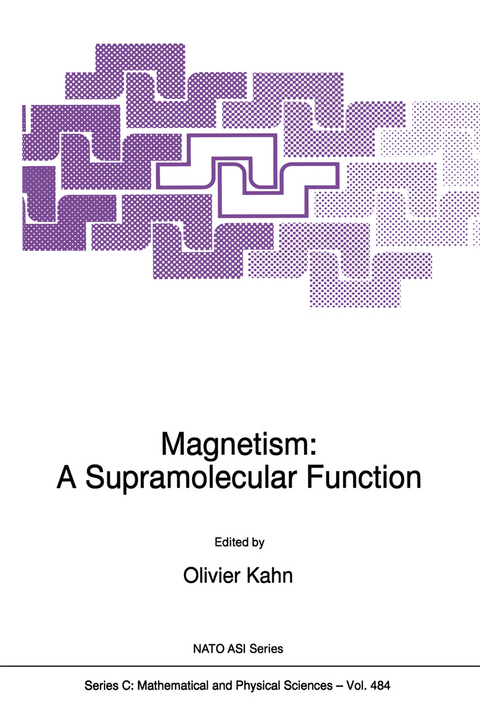
Magnetism: A Supramolecular Function
Springer (Verlag)
978-0-7923-4153-6 (ISBN)
At the core of research into molecular magnetism lie design and synthesis of new molecular assemblies exhibiting bulk properties such as long-range magnetic ordering or bistability with an hysteresis effect, which confers a memory effect on the system. In such terms, magnetism may be considered a supramolecular function.
The first eight contributions to this volume present the state of the art in organic supramolecular chemistry, emphasising interlocked systems and molecular trees. The following six articles are devoted to molecular materials constructed from organic radicals and transition metal units. Molecular bistability is then focused on, followed by metal-organic and coordination magnetic materials. A new approach to nano-sized particles closes the work.
Rotaxanes and Catenanes in Action.- Amide-Based Catenanes and Rotaxanes by Non-Ionic Template Synthesis.- Mechanically-Interlocked Molecules: Prototypes of Molecular Machinery.- The Assembly of New Materials Incorporating Macropolycyclic Bisurea Hosts.- Switchable Interlocked Molecules, Threaded Complexes and Interlocking in Crystals.- Towards Controllable [2]Catenanes and [2]Rotaxanes.- Electron-Reservoir Sandwich Complexes: From Mono- and Bimetallic Complexes to Molecular Trees.- Molecular Tectonics: Self-Assembly of Charged Molecular Tectons into One- and Two-Dimensional Solids.- Organic Cations in Molecular Recognition and Molecular Magnetism.- Assemblage of Organic Polyradicals with the Aid of Magnetic Metal Ions and Ordering of their Spins in Macroscopic Scales.- Organic Magnetic Polymers.- Organic Kagomé Antiferromagnet, m-MPYNN+·X?.- The Self-Assembly of Hydroxylated Phenyl ?-Nitronyl Nitroxide Radicals.- FT Pulsed ESR/ESTN (Electron Spin Transient Nutation) Spectroscopy Applied to High-Spin Systems.- The Design of Molecular Materials with Coexistence of Magnetic and Conducting Properties.- 1,2,4-Triazoles as Ligands for Iron(II) High Spin ? Low Spin Crossovers.- The Use of Dinucleating Tripodal Ligands in the Design of New Magnetic Materials.- Towards Control of the Intrinsic Characteristics of Spin-Crossover in Ferrous Materials.- Bistable Transition Metal Complexes.- High Nuclearity Manganese Carboxylate Clusters: Syntheses, Structural Characterization and Magnetic Properties.- Assembling Magnetic Blocks or How Long Does it Take to Reach Infinity?.- Copper(II)-Nitroxide Based Spin-Transition Like Species.- Ferromagnetic Interactions in Metal Complexes.- What is Special about Molecular Magnets?.- Solid State Supramolecular Chemistry of Oxalato-BridgedTransition-Metal Compounds with Two- and Three-Dimensional Connectivities — Structure, Magnetism and Photophysics.- Ligand Design Approaches for Controlling Exchange Coupling and Fabricating Molecular Magnetic Materials.- Long-Range Magnetic Ordering and Bistability in Molecular Magnetism.- Assembling Magnetic Blocks: A Strategy to Control the Nuclearity and Magnetic Properties of Polynuclear Complexes.- A Rationale Molecular Approach to High-Spin Molecules and Molecular Magnets.- Magnetic Properties of Metal Cluster Compounds. Model Systems for Nano-Sized Metal Particles.- List of Participants.
| Reihe/Serie | NATO Science Series C ; 484 |
|---|---|
| Zusatzinfo | XII, 660 p. |
| Verlagsort | Dordrecht |
| Sprache | englisch |
| Maße | 155 x 235 mm |
| Themenwelt | Naturwissenschaften ► Chemie ► Anorganische Chemie |
| Naturwissenschaften ► Chemie ► Physikalische Chemie | |
| Naturwissenschaften ► Physik / Astronomie ► Atom- / Kern- / Molekularphysik | |
| Naturwissenschaften ► Physik / Astronomie ► Elektrodynamik | |
| ISBN-10 | 0-7923-4153-8 / 0792341538 |
| ISBN-13 | 978-0-7923-4153-6 / 9780792341536 |
| Zustand | Neuware |
| Haben Sie eine Frage zum Produkt? |
aus dem Bereich


